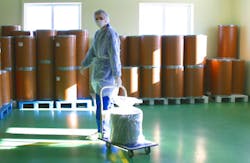The European Chemical Industry Council (Cefic) has made a downward revision of its projection for Europe's chemicals output in 2012, the organization has announced.
According to the latest estimate the total output of the European chemicals industry this year will contract by 2 percent compared to 2011 levels. This is a downgrade on the previous forecast released in September, with the change largely due to the stagnant European economy and a further decline in chemicals output since the first quarter of the year. However, Cefic expects a more positive development in 2013, with a predicted growth of 0.5 percent.
The biggest obstacle to growth this year has been subdued chemicals demand from the European Union automotive and construction sectors, which have both shown little hope for recovery, Cefic noted. Demand for new cars is still low, despite a number of government-backed incentives to replace old vehicles. Meanwhile, the European building sector remains at historically low levels.
RELATED: European chemical production posts 1.5 percent growth
Commenting on the sector performance, Cefic president Dr. Kurt Bock explained that the European chemicals industry is suffering from the economic downturn in Europe but the problem is not restricted to the region only, because other international markets are experiencing the same pressure.
As the European economy remains unstable amid austerity programs, high levels of sovereign debt, a surge in unemployment levels and low domestic demand, the outlook for the EU chemicals industry is far from rosy. It is predicted that chemicals production in 2012 will still be about 8 percent below its pre-recession level. Meanwhile, the European Commission expects the EU-27 economy to contract by 0.3 percent this year, with the prediction for 2013 hovering just above zero.
Elsewhere, the petrochemical sector is also in an uncertain situation, as fluctuating oil and naphtha prices are taking their toll at both ends of the chain, affecting producers and consumers alike. Still, consumer products are expected to be the only sub-sector in the chemicals industry to buck the negative trend, with another one percent growth expected in 2013 for all categories except for pharmaceuticals. The modest 0.5 percent output growth in 2013 for the chemicals sector as a whole, but excluding pharmaceuticals, is based on an optimistic projection of slight growth in every quarter after a slowdown in the second half of 2012.
On a global scale, export markets will likely be the only significant source of growth over the following 12 months, especially from BRIC countries. Concerns over the stability of the euro could emerge once again, as many uncertainties are still to be addressed, Cefic stated. Meanwhile, the United States is set to take advantage of its currently expanding chemical capacity and this might have an additional adverse effect on EU chemicals production.
The EU chemicals sector faces serious challenges, as the local market continues to struggle amid fierce overseas competition. EU policymakers need to act now to make sure they provide Europe with better conditions to help the industry recover from this difficult period, Bock added.
